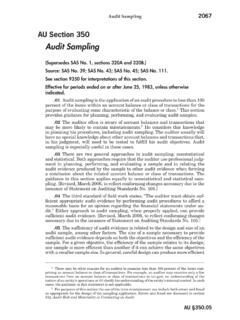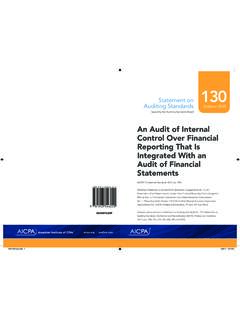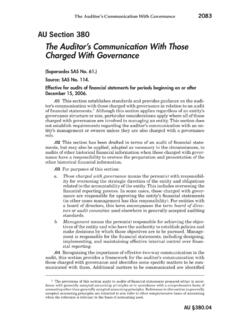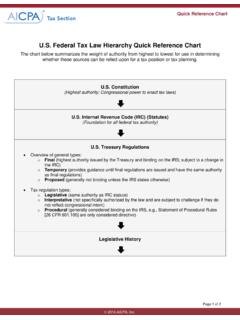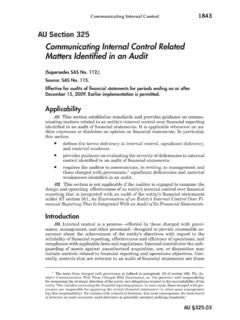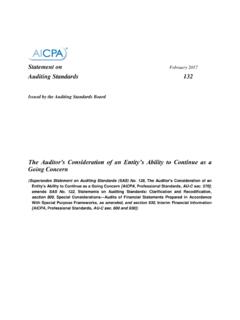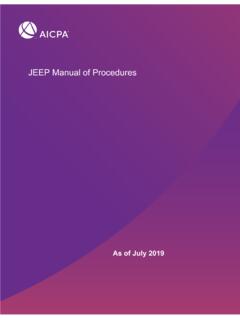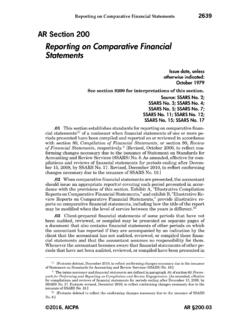Transcription of Materiality in Planning and Performing an Audit
1 Materiality in Planning and Performing an Audit347AU-C Section 320 Materiality in Planning and Performingan AuditSource: SAS No. 122; SAS No. 134; SAS No. for audits of financial statements for periods ending on orafter December 15, 2012, unless otherwise of This section addresses the auditor's responsibility to apply the conceptof Materiality in Planning and Performing an Audit of financial statements. Sec-tion 450,Evaluation of Misstatements Identified During the Audit , explains howmateriality is applied in evaluating the effect of identified misstatements onthe Audit and the effect of uncorrected misstatements, if any, on the in the Context of an reporting frameworks often discuss the concept of materi-ality in the context of the preparation and fair presentation of financial state-ments. Although financial reporting frameworks may discuss Materiality in dif-ferent terms, they generally explain that misstatements, including omissions, are considered to be materialif there is a substantial likelihood that, individually or in the ag-gregate, they would influence the judgment made by a reasonableuser based on the financial statements.
2 Judgments about Materiality are made in light of surrounding cir-cumstances and are affected by the size or nature of a misstate-ment, or a combination of both. judgments about Materiality involve both qualitative and quanti-tative considerations. judgments about matters that are material to users of the finan-cial statements are based on a consideration of the common finan-cial information needs of users as a group. The possible effect ofmisstatements on specific individual users, whose needs may varywidely, is not considered.[As amended, effective for audits of financial statements for periods ending onor after December 15, 2021, by SAS No. 138.].03 Such a discussion about Materiality provides a frame of reference tothe auditor in determining Materiality for the Audit . If the applicable financialreporting framework does not include a discussion of the concept of Materiality ,the characteristics referred to in paragraph.
3 02 provide the auditor with sucha frame of reference. 2020, AICPAAU-C Assessment and Response to Assessed auditor's determination of Materiality is a matter of professionaljudgment and is affected by the auditor's perception of the financial informa-tion needs of users of the financial statements. For purposes of determiningmateriality, the auditor may assume that reasonable a reasonable knowledge of business and economic activitiesand accounting and a willingness to study the information in thefinancial statements with reasonable diligence; that financial statements are prepared, presented,and audited to levels of Materiality ; the uncertainties inherent in the measurement ofamounts based on the use of estimates, judgment, and the con-sideration of future events; reasonable judgments based on the information in the fi-nancial statements.
4 [As amended, effective for audits of financial statements for periods ending onor after December 15, 2021, by SAS No. 138.].05 The concept of Materiality is applied by the auditor both in planningand Performing the Audit ; evaluating the effect of identified misstatements onthe Audit and the effect of uncorrected misstatements, if any, on the financialstatements; and in forming the opinion in the auditor's report. (Ref: par..A2).06In Planning the Audit , the auditor makes judgments about misstate-ments that will be considered material. These judgments provide a basis the nature and extent of risk assessment procedures; and assessing the risks of material misstatement; the nature, timing, and extent of further Audit Materiality determined when Planning the Audit does not necessarily es-tablish an amount below which uncorrected misstatements, individually or inthe aggregate, will always be evaluated as immaterial.
5 The circumstances re-lated to some misstatements may cause the auditor to evaluate them as ma-terial even if they are below Materiality . It is not practicable to design auditprocedures to detect all misstatements that could be material solely becauseof their nature (that is, qualitative considerations). However, consideration ofthe nature of potential misstatements in disclosures is relevant to the design ofaudit procedures to address risks of material addition, whenevaluating the effect on the financial statements of all uncorrected misstate-ments, the auditor considers not only the size but also the nature of uncorrectedmisstatements, and the particular circumstances of their (Ref: ) [As amended, effective for audits of financial statements for periods endingon or after December 15, 2021, by SAS No. 134.]Effective section is effective for audits of financial statements for periodsending on or after December 15, paragraphs.
6 A141 .A142 of section 315,Understanding the Entity and its Environmentand Assessing the Risks of Material Misstatement. [Footnote added, effective for audits of financialstatements for periods ending on or after December 15, 2021, by SAS No. 134.]2 Paragraph .A23 of section 450,Evaluation of Misstatements Identified During the Audit . [Foot-note renumbered by the issuance of SAS No. 134, May 2019.]AU-C 2020, AICPAM ateriality in Planning and Performing an objective of the auditor is to apply the concept of Materiality ap-propriately in Planning and Performing the purposes of generally accepted auditing standards (GAAS), the fol-lowing term has the meaning attributed as follows:Performance amount or amounts set by the audi-tor at less than Materiality for the financial statements as a wholeto reduce to an appropriately low level the probability that theaggregate of uncorrected and undetected misstatements exceedsmateriality for the financial statements as a whole.
7 If applicable,performance materialityalso refers to the amount or amounts setby the auditor at less than the Materiality level or levels for par-ticular classes of transactions, account balances, or Materiality is to be distinguished from tolerable mis-statement. (Ref: par..A3)RequirementsDetermining Materiality and Performance Materiality WhenPlanning the establishing the overall Audit strategy, the auditor should de-termine Materiality for the financial statements as a whole. If, in the specificcircumstances of the entity, one or more particular classes of transactions, ac-count balances, or disclosures exist for which there is a substantial likelihoodthat misstatements of lesser amounts than Materiality for the financial state-ments as a whole would influence the judgment made by a reasonable userbased on the financial statements, the auditor also should determine the ma-teriality level or levels to be applied to those particular classes of transactions,account balances, or disclosures.
8 (Ref: par..A4 .A14) [As amended, effective foraudits of financial statements for periods ending on or after December 15, 2021,by SAS No. 138.].11 The auditor should determine performance Materiality for purposesof assessing the risks of material misstatement and determining the nature,timing, and extent of further Audit procedures. (Ref: par..A15)Revision as the Audit auditor should revise Materiality for the financial statements as awhole (and, if applicable, the Materiality level or levels for particular classes oftransactions, account balances, or disclosures) in the event of becoming awareof information during the Audit that would have caused the auditor to havedetermined a different amount (or amounts) initially. (Ref: par..A16 .A17).13If the auditor concludes that a lower Materiality than that initially de-termined for the financial statements as a whole (and, if applicable, materialitylevel or levels for particular classes of transactions, account balances, or disclo-sures) is appropriate, the auditor should determine whether it is necessary torevise performance Materiality and whether the nature, timing, and extent ofthe further Audit procedures remain appropriate.
9 2020, AICPAAU-C Assessment and Response to Assessed auditor should include in the Audit documentation the followingamounts and the factors considered in their for the financial statements as a whole (see ) applicable, the Materiality level or levels for particular classesof transactions, account balances, or disclosures (see ) Materiality (see paragraph .11) revision of (a) (c) as the Audit progressed (see .13)Application and Other Explanatory MaterialMateriality in the Context of an Audit (Ref: par..06).A1 Identifying and assessing the risks of material misstatement4involvesthe use of professional judgment to identify those classes of transactions, ac-count balances, and disclosures, including qualitative disclosures, the misstate-ment of which could be material (in general, misstatements are considered tobe material if there is a substantial likelihood that, individually or in the aggre-gate, they would influence the judgment made by a reasonable user based onthe financial statements).
10 When considering whether misstatements in quali-tative disclosures could be material, the auditor may identify relevant factorssuch as the following: The circumstances of the entity for the period (For example, theentity may have undertaken a significant business combinationduring the period.) The applicable financial reporting framework, including changestherein (For example, a new financial reporting standard may re-quire new qualitative disclosures that are significant to the en-tity.) Qualitative disclosures that are important to users of the finan-cial statements because of the nature of an entity (For example,liquidity risk disclosures may be important to users of the finan-cial statements for a financial institution.)[Paragraph added, effective for audits of financial statements for periods endingon or after December 15, 2021, by SAS No.]
